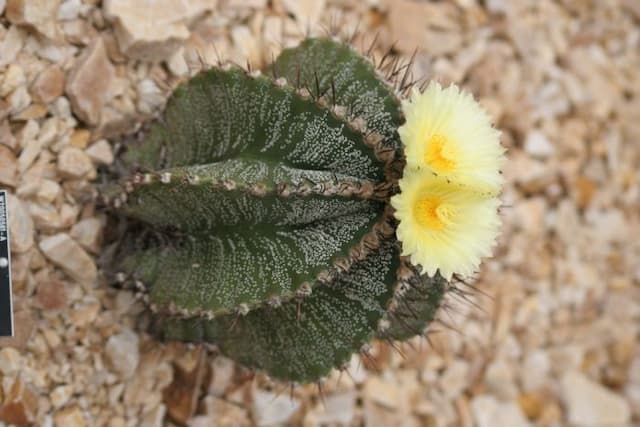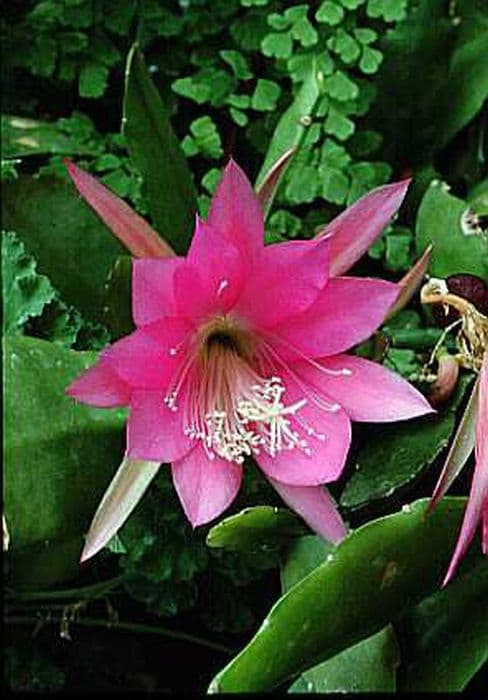Orange Crown Cactus Rebutia fiebrigii 'Muscula'

ABOUT
The Rebutia fiebrigii 'Muscula', commonly known as the Crown Cactus, is a small, globular plant often characterized by its dense clustering habit, producing many offsets. The main body of the Crown Cactus is rich green, covered in numerous spiny structures that can range in color from white to yellowish hues, providing a stark contrast to the verdant flesh of the plant. The spines are not only for protection but also help to shade the plant from intense sunlight. During the flowering season, the Crown Cactus produces vibrant flowers that emerge from the plant's crown, adding a splash of color that is especially striking against the plant's green body. These blooms are typically funnel-shaped and can come in a variety of shades including orange, red, or pink, depending on the specific cultivar. The petals are often bold and eye-catching, with a softer, more delicate inner part that may show subtle gradients of color and a brighter throat. The foliage of the Crown Cactus retains a succulent quality, which is common among plants that have adapted to store water within their tissues. The plant's overall appearance is compact and rounded, with the plethora of offsets giving it a full, clustered look. Its ornamental quality makes it a popular choice for cactus enthusiasts and those looking to add a touch of desert charm to their collection.
About this plant
 Names
NamesFamily
Cactaceae.
Synonyms
Orange Crown Cactus, Orange Snowball, Orange Mound Cactus.
Common names
Rebutia muscula, Rebutia canigueralii var. muscula, Rebutia pygmaea var. muscula
 Toxicity
ToxicityTo humans
Rebutia fiebrigii 'Muscula', commonly known as Crown Cactus, is not known to be toxic to humans. However, like all cacti, it has spines that can cause physical injury if handled without care. There are no reported symptoms of poisoning from ingesting this plant, as it is generally not considered poisonous.
To pets
Crown Cactus is not recognized as toxic to pets. It poses no known risk of poisoning if ingested, although the spines can cause discomfort or physical injury if a pet attempts to eat or play with the cactus. Therefore, while the cactus itself is not poisonous, caution should be taken to prevent injury from the spines.
 Characteristics
CharacteristicsLife cycle
Perennials
Foliage type
Evergreen
Color of leaves
Green
Flower color
Varies
Height
0.1 feet (3 cm)
Spread
0.1 feet (3 cm)
Plant type
Cactus
Hardiness zones
10
Native area
Bolivia
Benefits
 General Benefits
General Benefits- Decorative Appeal: The Rebutia fiebrigii 'Muscula', commonly known as the Crown Cactus, has a spherical shape and vibrant flowers that add an aesthetic touch to homes and gardens.
- Low Maintenance: This cactus species is suitable for people who prefer low-care plants due to its minimal watering and feeding requirements.
- Drought Tolerant: Its ability to store water makes it an excellent choice for xeriscaping and for those living in arid climate regions.
- Small Size: The compact size of the Crown Cactus is perfect for growing in small spaces or terrariums.
- Propagation: It's easy to propagate from offsets, allowing gardeners to expand their collection or share with friends.
- Pest Resistant: The Crown Cactus tends to be less prone to pests compared to other houseplants, reducing the need for pesticides.
- Long Lifespan: Cacti, in general, have long lifespans, with proper care the Crown Cactus can thrive for many years.
- Stress Reduction: Being around plants like the Crown Cactus can contribute to reduced stress levels and increased well-being.
 Medical Properties
Medical PropertiesThis plant is not used for medical purposes.
 Air-purifying Qualities
Air-purifying QualitiesThis plant is not specifically known for air purifying qualities.
 Other Uses
Other Uses- Miniature Garden Accents: The Rebutia muscula, with its small size and colorful blooms, can be used to create a visually appealing miniature garden or fairy garden setup.
- Photography Subjects: Due to their unique shape and bright flowers, Rebutia muscula plants can be great subjects for macro photography enthusiasts looking to capture nature's intricate details.
- Modeling Landscapes: These cacti can be used in model train setups or dioramas to add a touch of realistic desert scenery.
- Educational Tools: Rebutia muscula can be used in classrooms to teach students about plant biology, specifically how succulents adapt to arid environments.
- Artistic Inspiration: Artists may use the plant as a muse or subject for various forms of art, including painting, drawing, or sculpture.
- Stress Relief: Tending to a Rebutia muscula, like many forms of gardening, can serve as a stress relief activity and promote mental well-being.
- Biological Clock Studies: The flowering cycle of Rebutia muscula can be observed and used to study plant rhythms and the effects of light on biological clocks.
- Horticultural Challenges: Hobbyists may cultivate Rebutia muscula for competitive gardening, seeking to grow the most aesthetically pleasing or largest specimen.
- Theme Decorations: The unique look of Rebutia muscula can complement themes for events and parties, adding a natural yet exotic touch.
- Gift Giving: These low-maintenance plants make thoughtful gifts for plant enthusiasts or as a symbol of endurance and resilience.
Interesting Facts
 Feng Shui
Feng ShuiThe Balloon Cactus is not used in Feng Shui practice.
 Zodiac Sign Compitability
Zodiac Sign CompitabilityThe Balloon Cactus is not used in astrology practice.
 Plant Symbolism
Plant Symbolism- Resilience: Rebutia fiebrigii 'Muscula', commonly known as 'Crown Cactus', often symbolizes resilience due to its ability to thrive in harsh, rocky environments and adapt to very arid conditions.
- Beauty in Simplicity: The Crown Cactus is admired for its small, yet striking, flowers that bloom despite the plant's modest size, representing the beauty that can be found in simple, unassuming forms.
- Independency: As a cactus, it is very self-sufficient, requiring minimal water and care, which can symbolize the value of independence and self-reliance.
 Water
WaterThe Orange Snowball cactus should be watered sparingly as it is prone to rot if overwatered. During the active growth season in spring and summer, water when the top inch of soil feels dry, approximately every 7-10 days, using about 8-12 ounces of water depending on the size of the pot. In fall and winter, reduce watering to once a month to mimic its natural dormant period. Always use room temperature water and ensure the pot has good drainage to prevent waterlogging.
 Light
LightThe Orange Snowball cactus thrives in bright, indirect light but can tolerate direct sunlight during the cooler hours of the morning or late afternoon. The ideal spot for this cactus is near a south or east-facing window where it can receive ample light without being exposed to the harsh midday sun.
 Temperature
TemperatureThe Orange Snowball cactus prefers temperatures between 50°F and 80°F but can withstand brief dips down to 40°F. Keep the plant away from drafts and extremes of heat or cold to maintain its health. The ideal temperature range during its active growing season is 65°F to 75°F.
 Pruning
PruningPruning is typically not necessary for the Orange Snowball cactus unless it is to remove dead or damaged spines. If you must prune, do so using sterilized tools and only cut away the affected parts. The best time for any necessary pruning is in the spring when the cactus is entering its growth period.
 Cleaning
CleaningAs needed
 Soil
SoilThe best soil mix for the Crown Cactus should be fast-draining and gritty. A mix of 50% mineral grit such as coarse sand, perlite, or pumice and 50% potting soil works well. The ideal soil pH for the Crown Cactus is slightly acidic to neutral, around pH 5.5 to 7.5.
 Repotting
RepottingThe Crown Cactus should be repotted every two to three years or when the plant outgrows its pot. This will provide fresh nutrients and prevent the soil from becoming compacted.
 Humidity & Misting
Humidity & MistingThe Crown Cactus prefers low to moderate humidity levels, typical of arid environments. It thrives in indoor conditions where humidity is naturally lower, without the need for additional humidity control.
 Suitable locations
Suitable locationsIndoor
Place Crown Cactus in bright, indirect light indoors.
Outdoor
Grow Crown Cactus outdoors in bright shade or morning sun.
Hardiness zone
9-11 USDA
 Life cycle
Life cycleRebutia fiebrigii 'Muscula', commonly known as Orange Crown Cactus, starts its life cycle as a seed, typically requiring well-draining soil and warmth to germinate. After sprouting, the seedling slowly develops into a small, spherical cactus with spines and segmented ribs, entering a vegetative stage where photosynthesis fuels growth. As the cactus matures, it retains a globular shape, often producing offsets or "pups" that grow around its base. The mature Orange Crown Cactus then reaches the flowering stage, with bright orange-red flowers blooming in late spring to early summer, usually at the age of 3-4 years. Following pollination, possibly by insects, the flowers develop into small, fleshy fruits containing seeds that can disperse to start new cacti. The plant can live for many years, continuously producing flowers and seeds seasonally, with those that aren’t pollinated reabsorbing nutrients back into the plant.
 Propogation
PropogationPropogation time
Spring-Early Summer
Propogation: Rebutia fiebrigii 'Muscula', commonly known as Crown Cactus, is best propagated through the division of offsets. These are the small cacti that form at the base of the parent plant and can be carefully removed when they have formed their own roots. The ideal time to propagate by offsets is during the cactus's active growth period, which is typically in the spring or early summer. To propagate, gently twist the offset from the mother plant and allow the cut to callous over for a few days to reduce the risk of rot. Once the cut has hardened, the offset can be potted in a well-draining cactus mix. Water sparingly at first, just enough to moisten the soil without making it soggy, and gradually increase as the plant establishes. With proper care, these offsets will develop into mature, independent plants over time.









